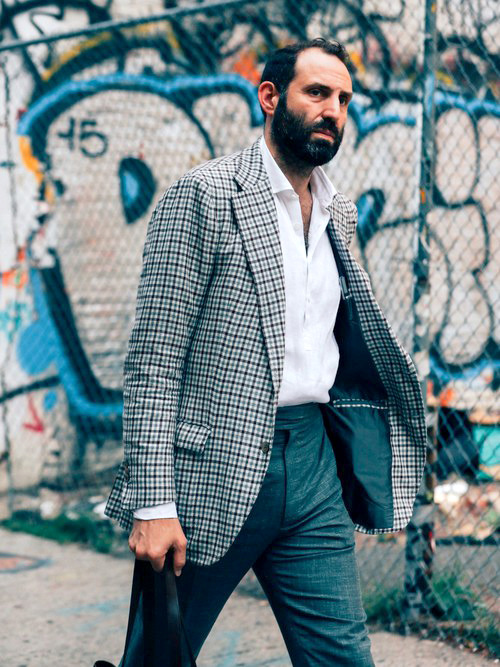
English fashion designer Hardy Amies had a simple rule for getting dressed: if it looks right, it is right. The only rule for combining colors is to create a visually pleasing outfit, but doing so requires more than transplanting concepts from art theory books. Fashion isn’t like other art forms, to the degree it can be called an art form itself, and you can’t combine colors for an outfit in the way an artist would for a painting. There’s a social and emotional language to clothing. A neatly folded, white linen pocket square says business in a way that other squares don’t.
Most people know the basics when it comes to color combinations. Grey trousers and blue jeans go with almost anything; dress shirts are often best in solid white and light blue. It’s moving beyond the basics that becomes challenging. How do you wear lighter colored sport coats? Which colors besides grey and tan work for trousers? How do you wear brighter, more unusual colors without looking like an Easter egg?
I recently spoke to Greg Lellouche about these questions. Greg, for those unfamiliar, is the founder of No Man Walks Alone (a sponsor on this site, although this isn’t a sponsored post). I’ve always admired Greg’s eye when it comes to color combinations. Before launching his online store, he worked as an investment banker on Wall Street, where he had to wear a suit-and-tie every day. At the same time, he often wears more progressive labels such as Stephen Schneider and Junya Watanabe on weekends. That appreciation for both classic men’s dress and avant garde casualwear, I think, gives him a unique perspective. Greg wears things that are a little off the beaten path, but in ways that I think are easy for others to adopt.
For obvious reasons, this guide mostly sticks to classic men’s style, just because doing so makes it easier to write in generalities. Casualwear is murkier, although we touch on some of it. At the end, we give some suggestions on how to incorporate more interesting colors into a wardrobe. Consider this a guide on how to color outside of the lines.
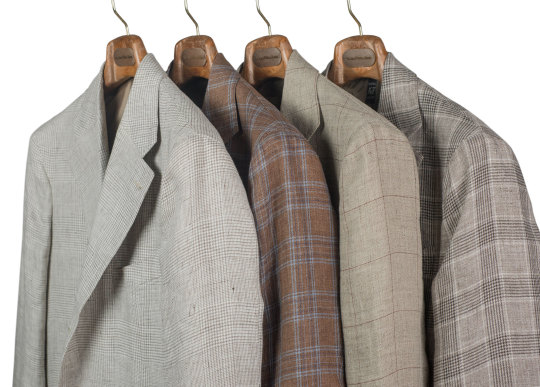
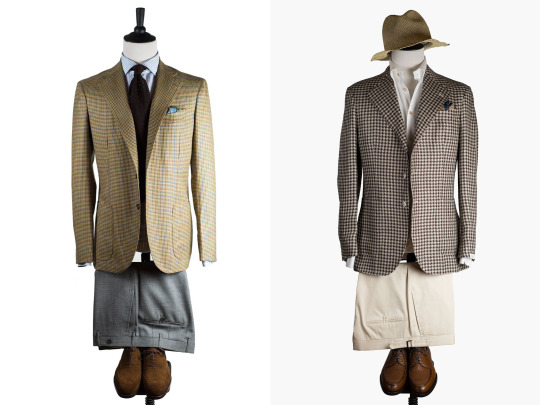
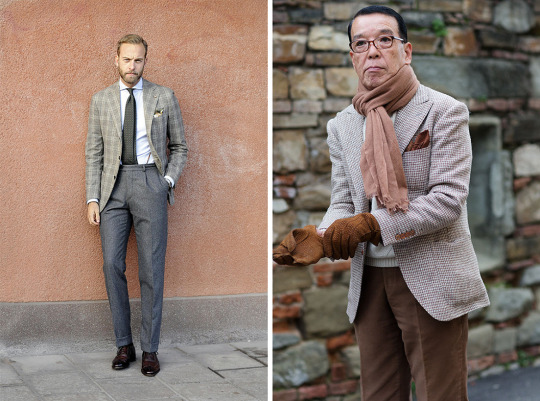
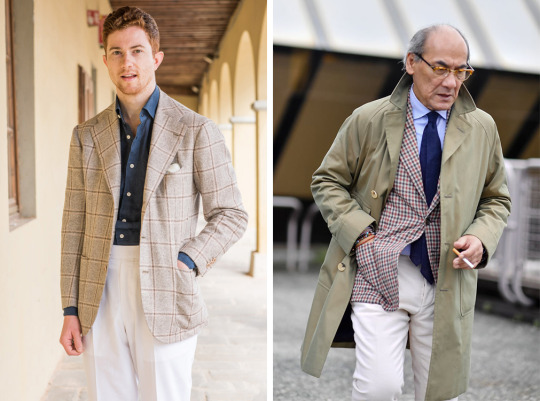
LIGHTER COLORED SPORT COATS
A traditional tailored outfit goes something like this: if it’s not a suit, the coat should be darker than the trousers, and the tie darker than the shirt. This visually brings the trousers and shirt into the background, allowing the jacket and tie to take center stage. Alan Flusser claims this helps draw the eye upwards, towards the wearer’s face, which is maybe why it’s also easier to wear shoes in dark brown or black. Generally speaking, you typically want the focus of your outfit to be on the upper half.
So then, what to do with lighter colored sport coats? Greg suggests sticking to the standard formula and wearing a pair of even lighter colored trousers, thus keeping the darker half of your outfit on the top. “The Italians tend to do this pretty well, with trousers that go all the way to white. But in the US, you don’t really see men wearing white pants,” says Greg. One option is to get something a little darker, but still stay lighter than your usual pair of khaki chinos. “Cream or oatmeal are good.”
The other way is to get trousers that are darker than your jacket, so you still maintain a bit of contrast between the lower and upper halves of your outfit. “The easiest solution is to stay within the same color family, but darken the shade,” says Greg. “A beige jacket will work with dark brown trousers; a light blue jacket will work with navy trousers. You can also always try charcoal, as it’s a fairly neutral color.”
Greg says he often wears lighter colored jackets with open neck, white shirts (“linen button-fronts or popovers, something more casual than a white poplin, spread collar”). I would also add darker blue shirts in a chambray, lightweight denim, or textured weave. If you feel the jacket and trousers are visually getting away from you, a darker blue shirt can help anchor everything, pulling the outfit together.
(photos via No Man Walks Alone, NYT, Andreas Wineas, The Sartorialist, and GQ)
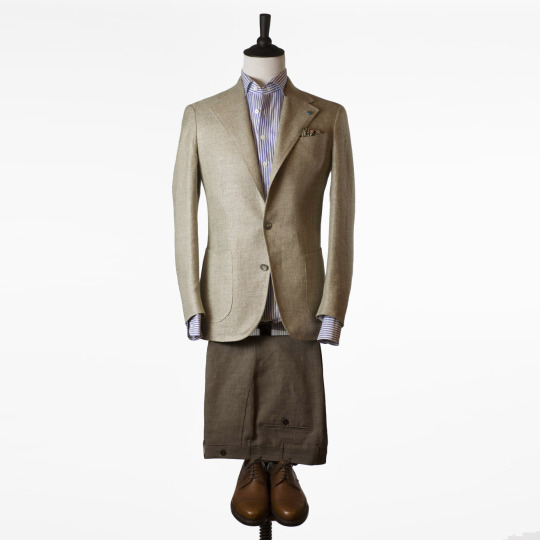
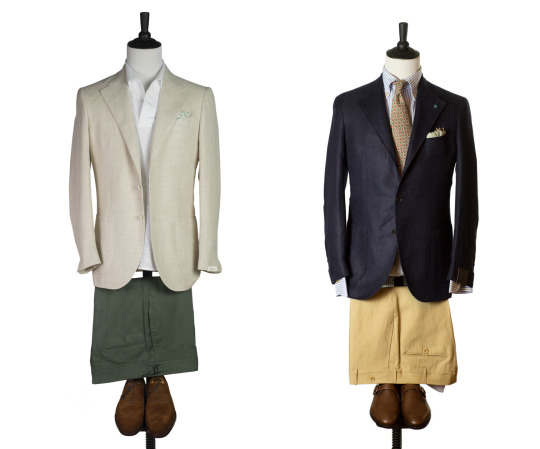
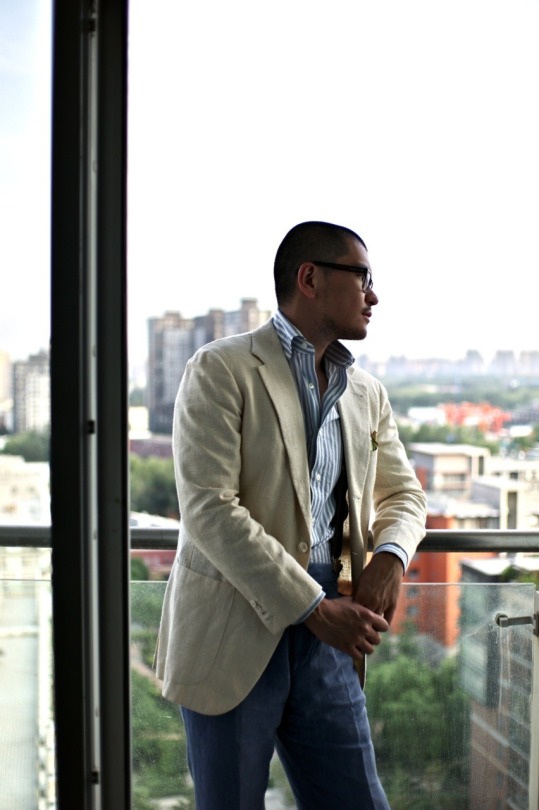
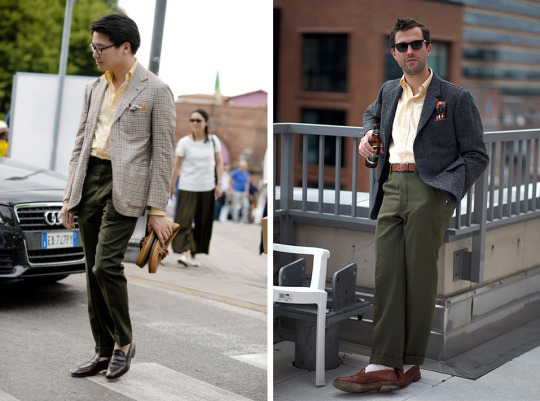
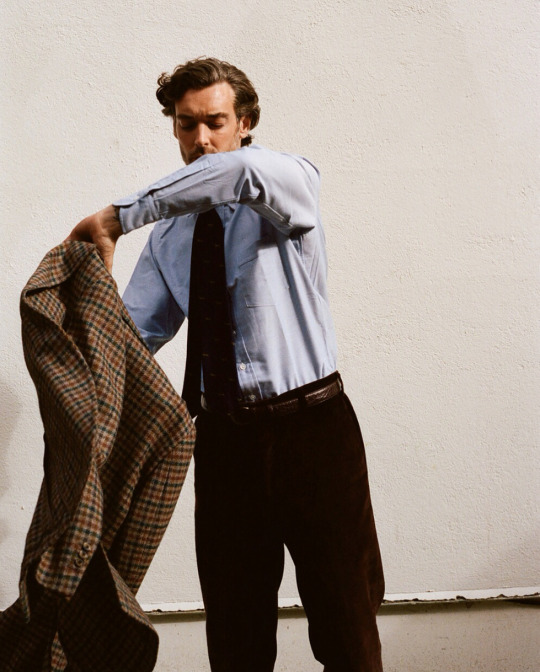

TROUSERS BEYOND GREY AND TAN
A million years ago, there used to be vociferous debates on Styleforum about the usefulness of navy trousers. Most felt trousers should be either grey or tan, as navy can be difficult to wear with tailored clothing. Greg, however, made the good point that navy trousers have been used forever in designer collections. “The other StyleForum rule is that you should never buy grey sport coats, but ironically enough, they go best with navy trousers,” he says. I still think grey and tan are your most useful trouser colors, although in the photo above, George Wang of Brio shows how great a pair of navy trousers can look with a cream colored, linen sport coat.
Greg says the trick is paying attention to the color’s temperature, whether it feels visually warm or cool. “If the blue has a bit of purple to it, it’ll be harder to wear with brown. Similarly, tan trousers can have a yellow cast that makes them look terrific with navy blazers, but awful with certain brown jackets,” he says. “Sometimes warmer and cooler colors can work together, but sometimes they don’t. It’s hard to create general rules here because things can be so case specific. Your best bet is to lay things out in front of you and see how things make you feel, but pay attention to the temperature.”
For medium to darker brown trousers, Greg suggests grey or navy sport coats. If you feel like temperatures are clashing, you can pull things together with warmer or cooler colored accessories (say, a warmer colored tie to match the warmth of an coat’s overcheck). Darker green cords can also be worn with other earthy tones for an autumnal outfit, while olive colored chinos can be a good way to coordinate with brown or grey sport coats. “Olive chinos can replace fatigues in a more casual outfit,” says Greg. “The eye is very trained to seeing that color because of Army pants.”
(photos via No Man Walks Alone, George Wang, The Armoury, Drake’s, Menswear Musings, and GQ)
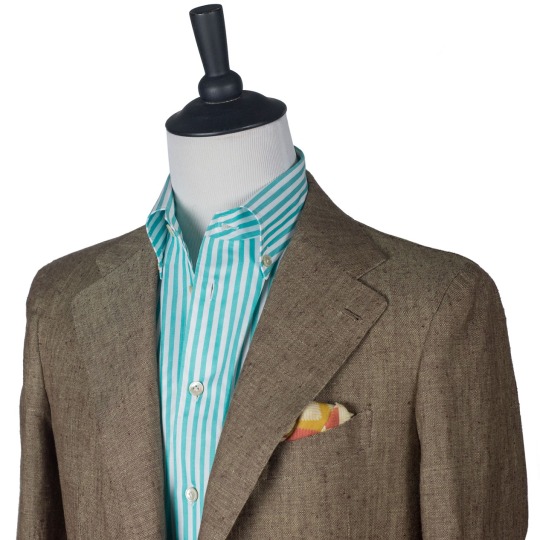

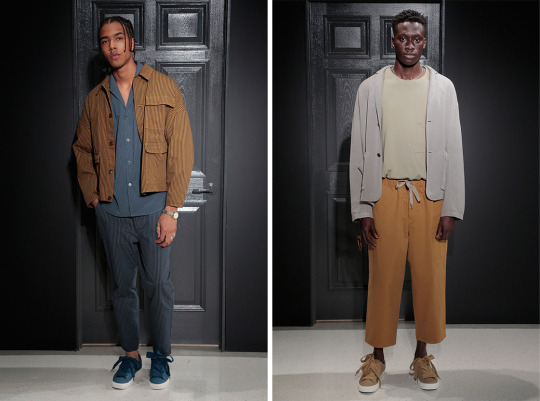
INCORPORATING UNUSUAL COLORS
Most men build their wardrobes around the same colors – blue, grey, and brown, accented with the occasional spot of green and burgundy. This is because the colors play well with each other, regardless if you’re in tailored clothing or casualwear. A brown tweed goes seamlessly with grey trousers, but you can also swap the coat out for a navy blazer for a different look. Similarly, casual jackets in olive, brown, or navy can be worn interchangeably with blue jeans and khaki chinos.
It’s nice to have a few brighter colors in your wardrobe, however. I find burgundy works surprisingly well for outerwear, transplanting what’s normally a color for accessories into what becomes a statement piece. Wine-colored bomber jackets and duffle coats can add a bit of liveliness to an ensemble. Dusty olive greens are terrific for linen or tweed sport coats. And saturated ochres are surprisingly underrated for knitwear and outerwear.
If you’re looking to incorporate more interesting colors into a wardrobe, Greg suggests starting with tops. “White dress shirts with alternating stripes in lilac, aqua green, or even yellow are a really great way to express a seasonal vibe,” Greg say. “I’ve yet to see cases where those things don’t work.”
Casualwear can be an entirely different ballgame. Greg suggests wearing this mint green Stephen Schneider shirt with Blue Blue Japan’s navy “easy pants” and summer-ready shoes, such as espadrilles or huaraches. Or these blue striped trousers from Robert Geller’s new line, Gustav Von Aschenbach, with a white top and black sneakers (“their mustard yellow jacket would also work,” he says). But these things become entirely contextual on the intended aesthetic, which makes it hard to generalize rules.
(photos via No Man Walks Alone, Voxsartoria, and Vogue)
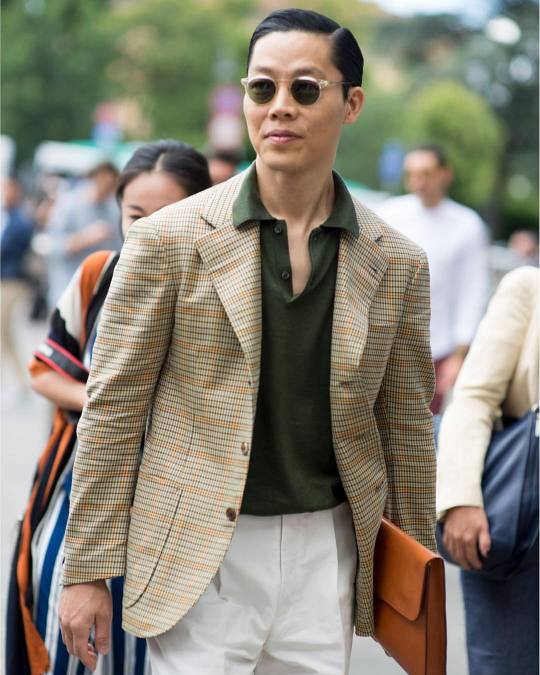
STEPS TOWARDS A MORE COLORFUL WARDROBE
So, what are some easily actionable steps towards a more colorful wardrobe? One is to get dress shirts in more interesting colors. A simple, blue-and-white striped shirt will always look great with a navy sport coat and gray wool trousers, but a lilac, pink, or aqua stripe lets you to turn a year-round outfit into something that more seasonal. I also find these more unusual colors are easier to wear as stripes, rather than solids, since the alternating white stripes help ground things.
You can also do a lighter colored gun club sport coat. “Get something with three or four colors, so it’s not just a Shepherds check,” says Greg. “When you have multiple colors like that, it’s easy to find a shirt, trouser, and tie combination. If you have a jacket with some grays, blues, and browns, you can wear it with khaki chinos or grey trousers. That way, the colors contrast, but also harmonize.”
Alternatively, beige colored jackets are tremendously easy to wear (shameless plug: the summer tweed I ran last year is now available as a ready-to-wear Formosa sport coat). Whether solid colored or discretely patterned, there’s something about a natural colored sport coat that’s easy on the eye. Pair it with trousers in a lighter or darker brown, navy, or even dark grey. They can also be worn with blue jeans, depending on the cut.
If you’re thinking about diversifying your trouser wardrobe, start with cream or sand. These will allow you to wear lighter and brighter colored sport coats, but they can also work with dark blue. Cream is good if you have things that on the warmer side of the color spectrum; sand is better for things that lean cool.
Lastly, for casualwear, Greg suggests starting with tops – tunics, sweatshirts, or linen knitwear. “Colors such as ochre, cream, or henna can be a great way to accent a basic olive or navy field jacket” he says. “We have some sweaters this season from Camoshita and Inis Meain that would work well.” I also like the idea of this wine-striped Camoshita popover with a brown suede Stoffa bomber jacket and khaki colored Rota chinos. Starting with a colorful top allows you to play around a bit more with your wardrobe without committing to an expensive jacket or be left wondering what to do with brightly colored trousers (shoutout to LAMFRT). It’s all about baby steps.
